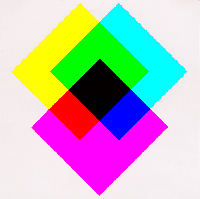Subtractive Mixture
Comparing with the Additive Mixture, the law of Subtractive Mixture takes place at an earlier stage within the Chain of Action Between Light And Color Sensation, namely in the material. It relates to the absorption capacity of translucent, i.e. transparent material. It requires the ink layers of the 3 Subtractive Basic Colors (SubBaCo) Yellow (Y), Magenta-red (M), and Cyan-blue (C). As key color the achromatic Basic Color White (W) is needed, to fill in the difference values. When projecting a chromatic slide (color slide) this key color is present by means of the white transmission light or in multicolor printing and aquarelle painting in form of the white paper surface.

Combining the ink layers of the 4 Subtractive Basic Colors W, Y, M, and C creates the other 4 Basic Colors R, G, B, and K.
The task of every chromatic filtering layer is to absorb in a spectral region and by doing this to activate the associated sensation force. It depends on the amount of dye existing on a particular image spot how much of the light energy will be absorbed by the corresponding layer. The Yellow (Y) filtering layer is absorbing in the short-wave range, the Magenta-red (M) layer in the medium-wave range and the Cyan-blue (C) layer in the long-wave range. Consequently, the Yellow layer modulates the sensation force Violet-blue (B), the magenta-red the sensation force Green (G) and the cyan-blue layer the sensation force Orange-red (R).
The non-absorbed portion of the light is transmitted. The light ray of one image spot penetrates all three transparent chromatic filtering layers, one after the other. As they are transparent, the corresponding absorption takes place in each filtering layer according to the amount of dye existing in it. The portion of light (residual light) which has not been absorbed on its passage through the three translucent chromatic layers enters the eye of the observer as color stimulus either directly or by reflection via the white paper surface. As absorption can vary from zero to 100% in each filtering layer, here again it is possible to stimulate the visual organ to generate the variety of colors .
In a Subtractive Mixture the 8 extreme color sensations, i.e. the 8 Basic Colors, are generated the following way :
Subtractive Basic Colors |
Color Sensation |
|
None |
= W |
 |
SubBaCo Y |
= Y |
 |
SubBaCo M |
= M |
 |
SubBaCo C |
= C |
 |
SubBaCo Y + M |
= R |
 |
SubBaCo Y + C |
= G |
 |
SubBaCo M + C |
= B |
 |
SubBaCo Y + M + C |
= S |
 |

 Functioning Principle of Vision
Functioning Principle of Vision Color Mixing Laws
Color Mixing Laws Color and Printing Process
Color and Printing Process Theory of Color
Theory of Color Teaching Material and Literature
Teaching Material and Literature